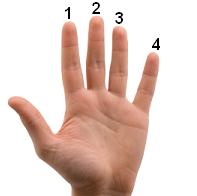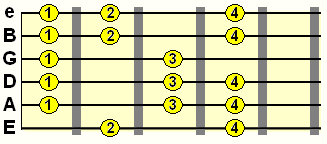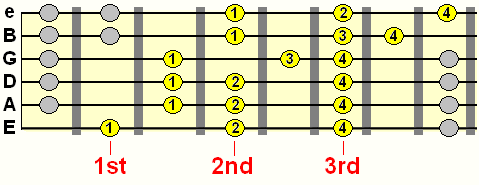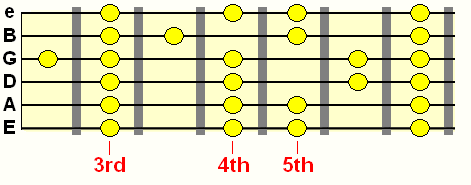Home
> Scales
/ Lead
> Practicing Scales 2
We started with the 1st position box pattern of the scale (I provide these patterns in the scale lessons on this site). Once you're confident with navigating these basic patterns at various tempos, it's time to expand out of the "starting box" and incorporate wider scale movements in your scale practice.
This is important for further developing your finger dexterity and freeing up your soloing so you can play fluidly and confidently across the entire fretboard. You will be amazed at how quickly your speed and improvisation skills develop if you follow this process.


Now we're going to play 3 notes on all 6 strings, which will give our fingers more of a stretch.
3 note per string patterns can be formed by linking together/overlapping patterns from 2 or 3 scale positions. I cover scale positions in their individual lessons, but using Lydian as an example again, we could use the following 3 notes per string pattern from its first 3 positions (the greyed out dots are the unused parts of these patterns in this example).

As you can see, we're now spanning a wider fretboard area, moving up into new territory. This pattern requires more of a stretch for your fingers and will provide you with some good exercises when practicing guitar scales, following the same metronome process outlined in part 1.
So, try navigating the 3 notes per string pattern using quarter notes, then 8th notes and finally 16th notes, increasing the metronome gradually as outlined in the first part.
You'll probably find these wider scale patterns more challenging to move around at higher speeds, but hopefully you'll notice more kinetic phrases jumping out of them. For example, we could incorporate string skipping to this pattern in exactly the same way we did with the boxed pattern in part 1 (we're in the key of A)...

Your fingering might change slightly as your movements get more complex. I've used a suggested fingering as a guide for that particular exercise.
Remember, you can link/overlap any 2 or 3 scale position patterns to create 3 notes per string. Below I've linked up Lydian's 3rd, 4th and 5th position patterns to create a wider pattern from which we could draw a 3 note per string pattern.
See if you can create a 3 note per string pattern starting at that 3rd position...

Let's take this concept a step further...
Here I take the 1st, 2nd and 3rd positions of Lydian...

Obviously we can no longer simply assign each of our fingers to a fret like with the boxed patterns - we'll have to move our fret hand position up and down with the pattern.
Try moving your hand position around the pattern and create your own exercises. One technique you can use to help merge these scale positions into one large pattern is to slide between them. Another is legato techniques such as hammer ons and pull offs. These are all covered in the lead section. However, just alternate picking every note is perfectly fine for practicing guitar scales now.
Like before, start at 80 BPM on the metronome and speed up gradually using quarter, eighth and sixteenth notes.
Use as much of the pattern as you can. Mix 3 notes per string with more confined "inside the box" movements. We're just getting used to the physical side of things at the moment. You'll naturally start seeking out musical scale phrases as your knowledge of the scale develops.
The key thing is to make sure you're constantly challenging yourself with wider movements and quicker tempos. But as we learned in part 1, don't jump ahead of yourself. Only push the metronome when you're comfortable with the current tempo.
Let's use the the same process of combining scale positions, but this time higher up the fretboard (we're still in the key of A)...

A really good exercise for this position is to use your index (1st) and pinky (4th) fingers in 6, or even 7 fret movements as part of a larger scale phrase, like in the following example...

Again, I've provided the suggested fingering, with the option of the 3rd or 4th finger on a couple of notes - find which one is most comfortable for you. Because the fret spacings are narrower higher up the fretboard, many players like to use their 3rd finger in places where their 4th finger would usually be positioned at lower frets.
Keep practicing guitar scales outside the box...
So, we're no longer constrained to playing in small boxes. Our fingers are moving free and wide, creating more interesting, dynamic movements.
Obviously we've only been using Lydian in the lesson examples, but the process and overall concept is exactly the same no matter which scale you're mastering. Scale positions and patterns are provided in the scales section, so it's just a case of creating larger patterns from these positions, creating your own exercises and challenging yourself using the metronome.
As you do this, your knowledge of the scale's harmonic qualities will naturally develop at the same time.
Next part coming soon
Guitar Scale Exercises
Learn Guitar Scales
Learn Lead Techniques
Practicing Guitar Scales Part 2
In the first part on practicing guitar scales, we learned a step by step process for developing our speed and timing using a metronome. This process should be followed throughout the coming lessons.

|
We started with the 1st position box pattern of the scale (I provide these patterns in the scale lessons on this site). Once you're confident with navigating these basic patterns at various tempos, it's time to expand out of the "starting box" and incorporate wider scale movements in your scale practice.
This is important for further developing your finger dexterity and freeing up your soloing so you can play fluidly and confidently across the entire fretboard. You will be amazed at how quickly your speed and improvisation skills develop if you follow this process.
Practicing guitar scales using 3 notes per string
Most 1st position patterns consist of a mix of 3 note and 2 note strings. For example, take the Lydian scale...

Now we're going to play 3 notes on all 6 strings, which will give our fingers more of a stretch.
3 note per string patterns can be formed by linking together/overlapping patterns from 2 or 3 scale positions. I cover scale positions in their individual lessons, but using Lydian as an example again, we could use the following 3 notes per string pattern from its first 3 positions (the greyed out dots are the unused parts of these patterns in this example).

As you can see, we're now spanning a wider fretboard area, moving up into new territory. This pattern requires more of a stretch for your fingers and will provide you with some good exercises when practicing guitar scales, following the same metronome process outlined in part 1.
So, try navigating the 3 notes per string pattern using quarter notes, then 8th notes and finally 16th notes, increasing the metronome gradually as outlined in the first part.
You'll probably find these wider scale patterns more challenging to move around at higher speeds, but hopefully you'll notice more kinetic phrases jumping out of them. For example, we could incorporate string skipping to this pattern in exactly the same way we did with the boxed pattern in part 1 (we're in the key of A)...

Your fingering might change slightly as your movements get more complex. I've used a suggested fingering as a guide for that particular exercise.
Remember, you can link/overlap any 2 or 3 scale position patterns to create 3 notes per string. Below I've linked up Lydian's 3rd, 4th and 5th position patterns to create a wider pattern from which we could draw a 3 note per string pattern.
See if you can create a 3 note per string pattern starting at that 3rd position...

| So what is
the benefit of practicing guitar scales using wider patterns?
They encourage more fluid movements, such as slides and legato playing (e.g. hammer ons, pull offs) across wider intervals, creating more dynamic solos. Rather than restricting yourself to the same 4/5 fret box, you're giving your fingers more freedom to roam and really explore the scale's tonality. |
Let's take this concept a step further...
Practicing scales using even more of the fretboard
Using the same concept of combining patterns from multiple scale positions, we can create larger patterns to free up our scale movements even more.Here I take the 1st, 2nd and 3rd positions of Lydian...

Obviously we can no longer simply assign each of our fingers to a fret like with the boxed patterns - we'll have to move our fret hand position up and down with the pattern.
Try moving your hand position around the pattern and create your own exercises. One technique you can use to help merge these scale positions into one large pattern is to slide between them. Another is legato techniques such as hammer ons and pull offs. These are all covered in the lead section. However, just alternate picking every note is perfectly fine for practicing guitar scales now.
Like before, start at 80 BPM on the metronome and speed up gradually using quarter, eighth and sixteenth notes.
Use as much of the pattern as you can. Mix 3 notes per string with more confined "inside the box" movements. We're just getting used to the physical side of things at the moment. You'll naturally start seeking out musical scale phrases as your knowledge of the scale develops.
The key thing is to make sure you're constantly challenging yourself with wider movements and quicker tempos. But as we learned in part 1, don't jump ahead of yourself. Only push the metronome when you're comfortable with the current tempo.
| If you
want a break from the
metronome, try playing the Lydian pattern
above over the backing track below. We're in the key of A, so that
means the 1st position root (E string, 5th fret) will
be the note A and
the pattern continues from that point. Download the backing track here |
Practicing scales beyond the 12th fret
Obviously you'll want to be able to solo confidently higher up the fretboard. The frets are narrower, meaning you can play even wider intervals per string without changing fret hand position.Let's use the the same process of combining scale positions, but this time higher up the fretboard (we're still in the key of A)...

A really good exercise for this position is to use your index (1st) and pinky (4th) fingers in 6, or even 7 fret movements as part of a larger scale phrase, like in the following example...

Again, I've provided the suggested fingering, with the option of the 3rd or 4th finger on a couple of notes - find which one is most comfortable for you. Because the fret spacings are narrower higher up the fretboard, many players like to use their 3rd finger in places where their 4th finger would usually be positioned at lower frets.
Keep practicing guitar scales outside the box...
So, we're no longer constrained to playing in small boxes. Our fingers are moving free and wide, creating more interesting, dynamic movements.
Obviously we've only been using Lydian in the lesson examples, but the process and overall concept is exactly the same no matter which scale you're mastering. Scale positions and patterns are provided in the scales section, so it's just a case of creating larger patterns from these positions, creating your own exercises and challenging yourself using the metronome.
As you do this, your knowledge of the scale's harmonic qualities will naturally develop at the same time.
Next part coming soon
| |
Tweet |
Stay updated and learn more
Sign up to the newsletter for updates and grab your free Uncommon Chords book
Sign up to the newsletter for updates and grab your free Uncommon Chords book
Related
Guitar Scale Exercises
Learn Guitar Scales
Learn Lead Techniques








